In May of 2013, I finally met this tea-bro in person.
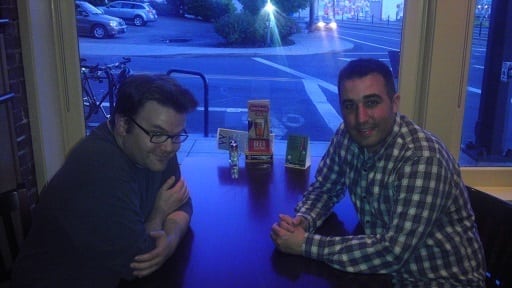
Tony Gebely—award-winning tea blogger, tea business insider, and all-around nice guy. When we first met, we did what any self-respecting tea people would do on first impression. We drank beer.
While we were downing pints, he mentioned he was working on a book, and ran the title by me. He wanted to call it: Tea: A User’s Guide. I told him I dug it, and that he should keep me posted on its release.
Four years flew by. A lot happened to Tony in that intervening period. He single-handedly disproved my “tea and dating” theory . . . by marrying his tea date. He worked for two different giant tea companies. And, last but not least, somehow found time for a kid.
So, with good reason, the book took a while. But in the fall of 2016, he chimed with a message that the book was near release. He wanted to send me two things: (1) some tea, and (2) an online copy of the new book, followed by a paperback at a later date. I had a horrible track record with book reviews. (As in, I hadn’t done a single full book review, yet.) But I didn’t tell him that.
In November, I got the copies of said book.

It was, indeed . . . a book.
The design was sleek and minimal. It looked every bit the “technical manual but for tea” approach he pitched to me all those years ago. I dug into the digital copy first, and I got about forty-five pages through. That was a record.
Confession: I’m a slow-arse reader. That and I can’t stand reading nonfiction. It’s a chore. Speculative fiction is my comfort zone. A dry, technical manual style book about everything tea might as well have been a brain laxative. The stuff that I did read intrigued me; some of it I already knew, some I didn’t. And I had no gripes with the grammar or terminology, save a nitpick about the use of “variety”. Eventually, I put it down, and I didn’t pick it back up. It gathered dust right by my computer.
In the interim, I finally dove into one of the teas Tony sent me. And it was . . . um . . .
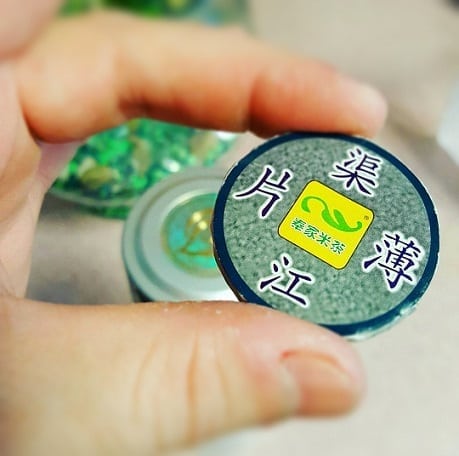
What the hell was it?
It was a pressed coin. The label was in Chinese, but there was no alternate label in ‘Merican. I posted the above photo announcing my ignorance. Was it a heicha? Puerh? Some weird hybrid sex-monster creation of both?
Tony chimed in and said it was a Hunan heicha. Qu Jiang Bao Pian, to be precise. That led to a digressive conversation about the nature of heicha. I wondered aloud what the difference between shou puerh and other Chinese heicha was.
Tony coyly replied, “You’ll have to read the book to find that out.”
Sneaky bastard! I thought.
Of course, I didn’t take up his challenge until several months later. When I finally got the gumption to dig through the book, I also decided to “pair” the book perusal with the heicha coin. Seemed a fitting venture. As to the coin itself . . .
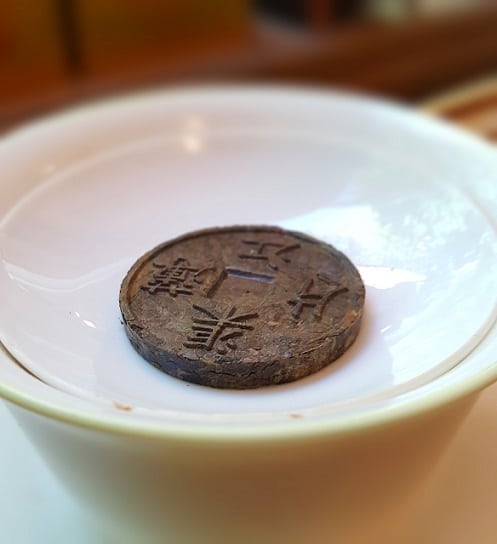
My Google Translate app read the wrapper as “Ju Feng Jia Mi Cha Jiang”, which translated to “Ju Feng Home Rice Tea”. Uh . . . I decided to go with Tony’s word on this one. Nice try, though, Google.
Anyway, the coin broke apart in seconds when put in contact with boiled water. Like, within the first pre-wash, the pressed leaves completely dispersed. Also in that time, the liquor colored oil red-brown, like a Yunnan shou puerh. I mean, I know shou puerh and heicha are closely related, but non-Yunnan dark teas usually brewed up at least a little lighter.
Thankfully, it didn’t really taste like a shou. Well, it “kinda” did, but only on the intro—that whole “earth and jujubes” thing. The rest was far smoother and sweeter, with notes of molasses and a bit of . . . soil.

What? Soil can be delicious. I was five once; I liked dirt. Don’t judge me!
I dug it, but I’ve been finding that the case with a lot of non-Yunnan heichas, lately. One could even say I was on a bit of a heicha kick. Whatever the “kick” part is supposed to mean. But that’s a story for another time. I had a book to dip into.
So, what did Tony have to say about heicha and puerh, and their differences? Unfortunately, I didn’t remember the pages he specified to look at. Best to see if the book had a glo—. . .
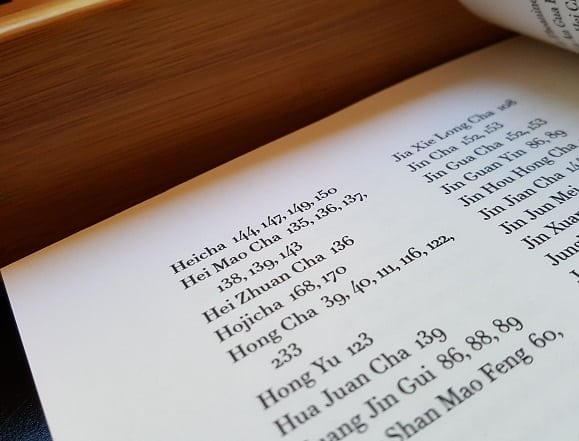
Holy crap! The book had a glossary!
I did not know that! For some reason, I thought I would have to sift through the chapters, y’know, reading the darn thing, looking for mentions of heicha. But nope! He had the keyword there, and the pages where it was pertinent. Like an actual bit o’ reference material. So, I thumbed through the pages he specified.
But before I got there, I found the page with the exact tea I was drinking!
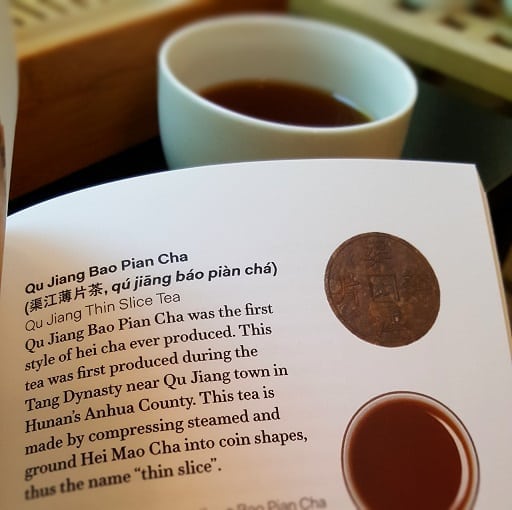
Now, I don’t even have to explain it to you guys. It’s all right there. First heicha ever produced. Huh! Color me surprised. However, all of this, and some information preceding it about other types of heicha, came before the specified “Heicha” pages listed in the glossary. Minor nitpick, but still there.
While interesting, that didn’t answer my question of what set shou puerh and other heichas apart. So far, all I learned was that most provincial Chinese heichas went through a process called “Wo Dui” (wet-piling), wherein the leaves were . . . well . . . piled while they were wet. They just lay there for days, weeks or months on end, and occasionally more moisture was added—depending on the type of dark tea being produced.
In the section on shou puerh, the only point in the process that differed from other heicha was the leaf drying phase. The unfinished tea leaves for puerh had to be dried in the sun; whereas with other heicha types, the leaves could be dried in a large room. What was not mentioned, however, was the introduction of bacterial cultures to shou puerh. That process also set it apart from other heicha.
I’m not sure if Tony didn’t know of this, or if it was a process only recently brought to light. Frankly, I wasn’t enough of an expert on the subject to consider this a demerit. The jury was still out on whether all shou was subject to this process. For the moment, I’ll just say that the main difference was the sun-drying requirement for Yunnan grown-‘n-made shou puerh.
Hey, that was more than I knew a half-hour before writing this. I learned more about the tea I was drinking, to boot. So, as a legitimate user’s guide to tea, Tea: A User’s Guide is exactly as advertised. While I’m sure some would appreciate reading it from cover-to-cover, for those that wince at the idea, it can be dissected for pertinent information in sections as well. Like the manual it was intended to be.
Long story short, it’s worth a read—either partial or prolonged. I suppose no one can really call this a review in the strictest sense. I don’t care. I tell stories . . . even about books.
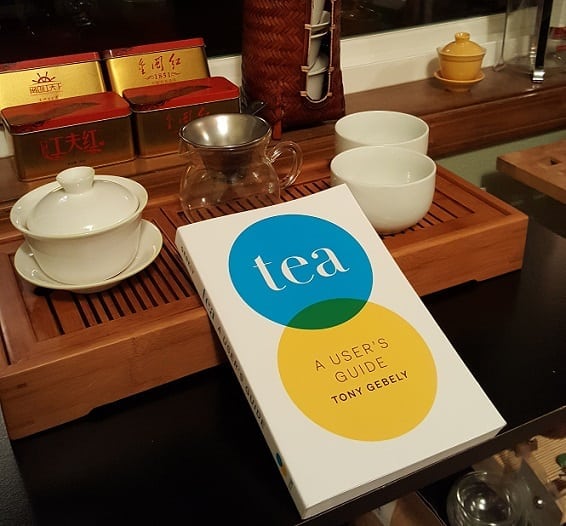
You can buy Tony’s book HERE.

Barb Stephens
Great, great review article Geoffrey. I really enjoyed reading about this book that I have not purchased yet. I especially liked the pages you included and your funny wit. You are a good writer and reviewer. Keep up the good work. -Barb
lazyliteratus
Thanks for the compliment, Barb!
Han Gerber
Great piece and very timely for me as well as I have gotten onto a kombucha kick and need to refocus on Gong fu cha! Will start by buying Tony’s book right NOW.
lazyliteratus
A kombucha kick?! Wow, that’s hardcore.
Fel
The world of kombucha is just as immersing — after all, it’s all about the tea! We’ve fermented everything from delicate whites to dark shou — including weird teas like golden flower heicha. And then there’s Guayusa, Kudingcha, Greek Mountain and Anchan — all herbals. #nolimits
lazyliteratus
Agreed on the limitless possibilities.
Margo Hutchinson
I think this is the kind of book you keep around when you have a question and want to look things up “about tea”. And with you there are probably ideas you want to look up several times a day! Glossaries are wonderful!!
lazyliteratus
Glossaries are, indeed, wonderful.
Xavier
After reading your review, I think I really need to start this book.
Leona
Nice post and thanks for a little sneak peak – I haven’t picked up Tony’s book yet, but the glossary is a great idea. ‘Soil’ is a great taste.
Also, “Jia Mi Cha” literally translates into ‘Home Rice Tea” haha 🙂
lazyliteratus
Wow! That is funny! Google was spot on.
Nicole Martin
Tony’s book has definitely been a great reference source for me. I have the amazing ability to read just about anything cover to cover but this one wasn’t bad at all, especially as far as non-fiction goes 🙂